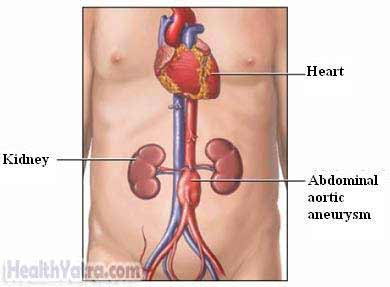Definition
The aorta is the body’s largest artery. It carries blood from the heart and delivers it to the rest of the body. The aorta travels through the chest and the abdomen. An aortic aneurysm is a weak, bulging area in the wall of the aorta. The bulging develops from a weakness or defect in the aortic wall. It tends to get bigger with time.
The greatest danger is that an aneurysm will rupture. This will cause heavy, uncontrollable bleeding. Aortic aneurysms can also occur with aortic dissection. Dissection is a small tear in the aortic wall. Blood from the aneurysm can leak through this tear and spread between the layers of the aortic wall. This leads to eventual rupture of the vessel.
Aneurysms can develop anywhere. They are most common in the aorta, iliac artery, and femoral artery.

Causes
Atherosclerosis is frequently associated with aneurysm. However, it is not thought that this disease alone causes the growth of an aneurysm. It is believed that other factors, such as high blood pressure or connective tissue disorders, must be present for an aneurysm to form.
Risk Factors
Factors that increase your chance of getting an aortic aneurysm include:
- High blood pressure
- Smoking
- Arteriosclerosis, atherosclerosis
- Inherited connective tissue defects such as Marfan syndrome and Ehlers-Danlos syndrome)
- Polyarteritis nodosa
- Bacterial endocarditis
- Syphilis
- Age: 60 or older
- History of heart attack
- Obesity
- Family members with aneurysms, particularly male children of an affected mother
- Infectious aortitis
- Great vessel arteritis, also known as Takayasu’s disease
- Injury to the aorta, from either a motor vehicle accident or a stab wound
Symptoms
Many aneurysms do not have symptoms. They are detected during a routine physical exam or during x-ray evaluation for another disorder.
Symptoms may occur when the aneurysm grows or disrupts the wall of the aorta. Symptoms depend on the size and location of the aneurysm and may include:
- Pain in the abdomen or in the lower back
- Boring, gnawing, or constant pain occurring over hours or days
- Sudden onset of severe stabbing pain
- Unusual sensation of pulsing in the abdomen
- Cough, shortness of breath
- Fainting
- Hoarseness
- Difficulty swallowing
- Coughing up blood
- Weight loss
- Chest pain
Diagnosis
The doctor will ask about your symptoms and medical history. A physical exam will be done. Pain is the symptom that will most likely cause you to go to the doctor. Most aortic aneurysms are discovered during a routine physical exam.
Your doctor may need pictures of your heart. This can be done with:
- Abdominal or chest x-ray
- Abdominal or chest ultrasound
- Computed tomograpy (CT) scan of the abdomen or chest
- Magnetic resonance imaging (MRI) scan of the abdomen or chest
- Aortography
- Transesophageal echocardiography
- Cardiac catheterization
Treatment
Treatment includes surgery or stenting.
Surgery
Surgery to repair an aortic aneurysm is called aneurysmectomy. It involves removing the portion of the aorta that contains the aneurysm and replacing it with a mesh graft.
With aneurysms of the thoracic aorta, the aortic valve may also be affected and need to be replaced or repaired. If the aneurysm involves important branches of the aorta, these vessels may either be repaired or bypassed.
When deciding whether to operate, the doctor will consider:
- Your age
- Your general health
- Your symptoms
- The size of your aneurysm
- Associated disease such as kidney failure or stroke
- If the aneurysm has ruptured or not
- If you’ve had a recent heart attack
Stenting
Depending on where the aneurysm is located and how complex it is, stenting may be done. A stent-graft is a polyester tube covered by a tubular metal web. The stent-graft is inserted into the aorta. With the stent-graft in place, blood flows through the stent-graft instead of into the aneurysm, eliminating the chance of rupture.
Prevention
There are no guidelines for preventing an aneurysm because the cause is not known. However, you can reduce some of your risk factors by following these recommendations:
- Eat a healthful diet that is low in saturated fat and rich in whole grains, fruits, and vegetables.
- Don’t smoke. If you smoke, quit.
- The US Preventive Services Task Force recommends that men aged 65-75 who have ever smoked be screened once for abdominal aortic aneurysm withultrasound. This is a painless procedure that gives a picture of the abdomen using sound waves. Early detection of abdominal aortic aneurysm in this group has been shown to reduce mortality from this condition.
- Maintain a healthy weight.
- Begin a safe exercise program with the advice of your doctor.
- Seek treatment for high blood pressure, syphilis, and other infections.
- If you have Marfan syndrome, see your doctor regularly for monitoring and CT scans.
Aortic Aneurysm Treatment in India – Page Keywords:
Aortic Aneurysm Definition, Aortic Aneurysm Definition Causes, Aortic Aneurysm Symptoms, Aortic Aneurysm Treatment in India, Aortic Aneurysm Treatment Cost in India, Aortic Aneurysm Surgery Cost, Top Aortic Aneurysm Treatment Hospital, Top Aortic Aneurysm Treatment Doctor in India, Aortic Aneurysm Meaning in Marathi, Aortic Aneurysm Treatment Near me, Aortic Aneurysm Complications, Travel India for Aortic Aneurysm Treatment, Aortic Aneurysm Treatment in Arab Countries, Aortic Aneurysm Treatment in Bangladesh, Aortic Aneurysm Treatment in Dhaka, Aortic Aneurysm Meaning in Bengali, Aortic Aneurysm Meaning in Arabic, Aortic Aneurysm Meaning in Hindi, Aortic Aneurysm Treatment in Bahrain, Aortic Aneurysm Treatment in Egypt, Aortic Aneurysm Treatment in Iraq, Aortic Aneurysm Treatment in Jordan, Aortic Aneurysm Treatment in Kuwait, Aortic Aneurysm Treatment in Lebanon, Aortic Aneurysm Treatment in Saudi Arabia, Aortic Aneurysm Treatment in United Arab Emirates, Aortic Aneurysm Treatment in Sudan, Aortic Aneurysm Treatment in Tunisia, Aortic Aneurysm Treatment in Nepal, Aortic Aneurysm Treatment cost,
